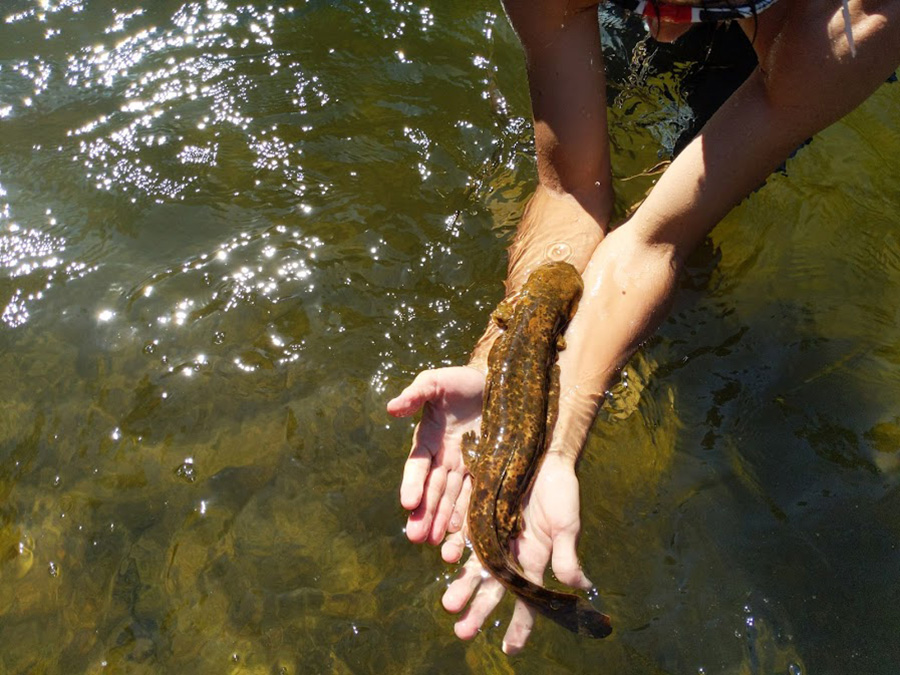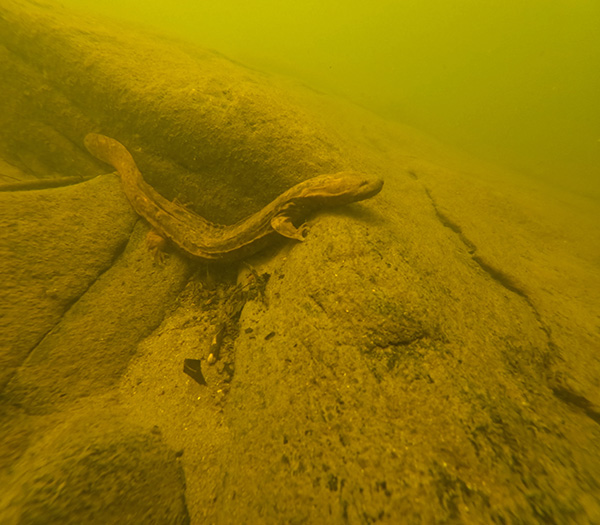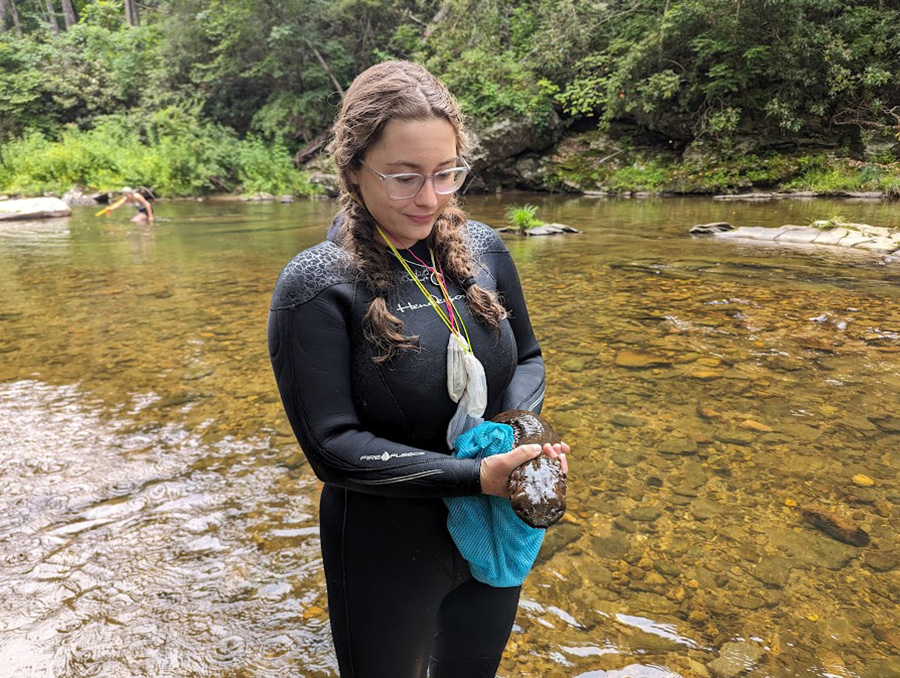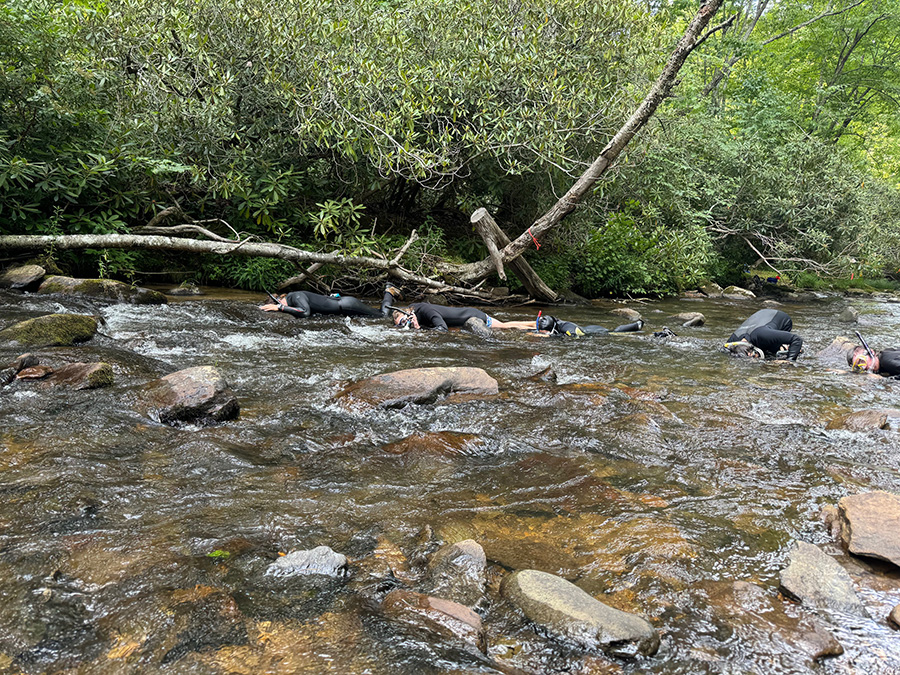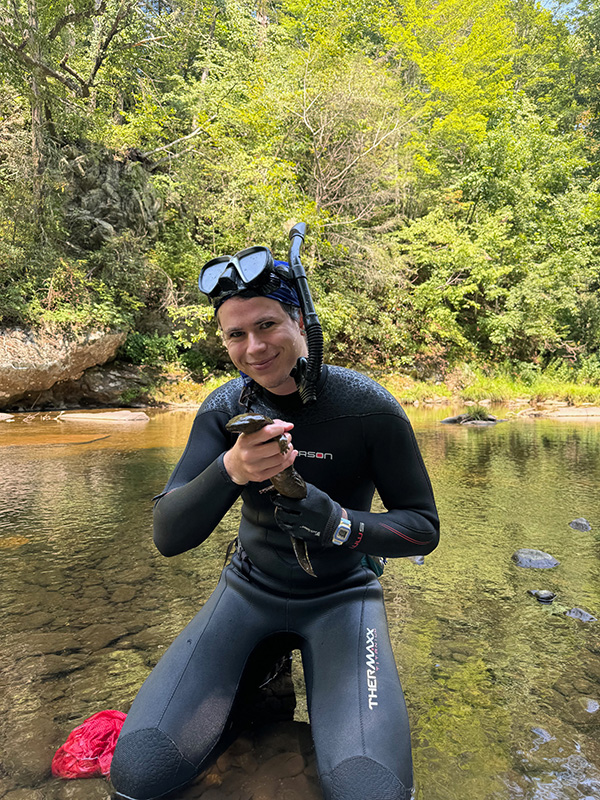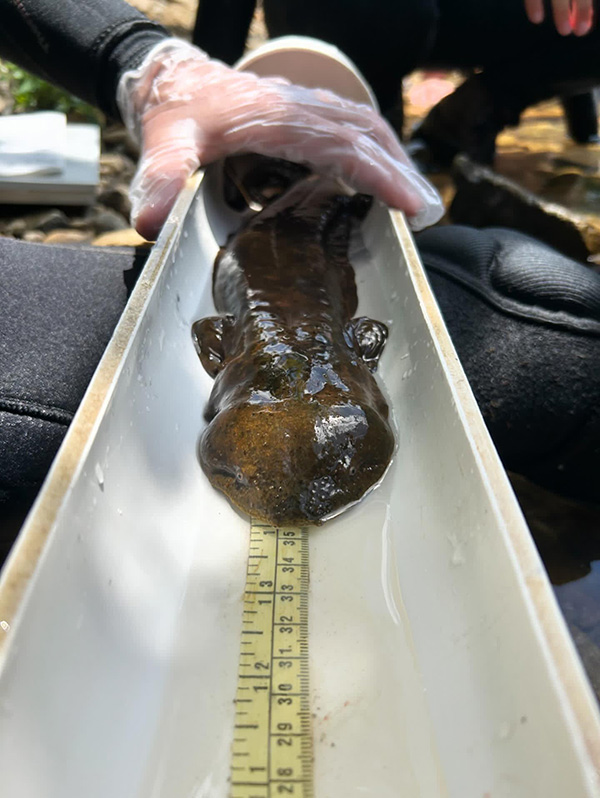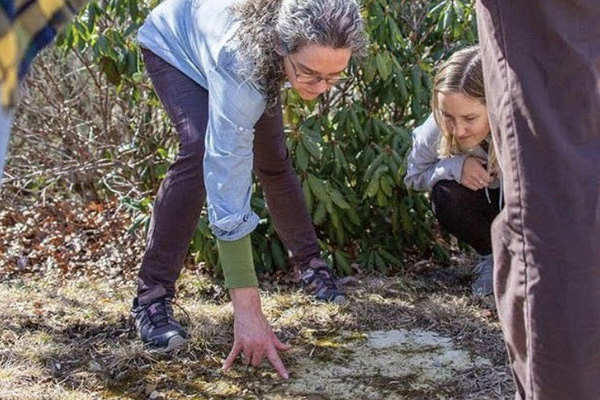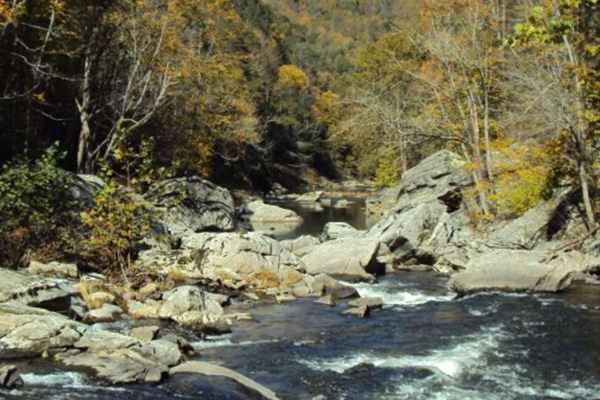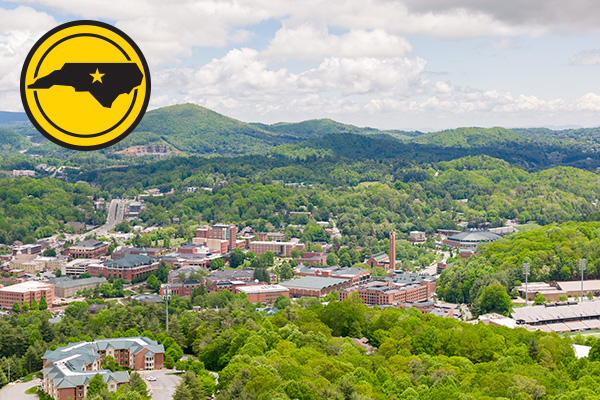BOONE, N.C. — Slithering in the rocky streams and rivers of the eastern United States is a rare species of giant salamanders known as hellbenders. Dr. Michael Gangloff, professor in Appalachian State University’s Department of Biology, has been researching the amphibians for nearly two decades. Recently, his lab assisted a team tasked with transferring the giant salamanders from the now removed Shull’s Mill Dam on the Watauga River to a newly restored habitat downstream.
“Our goal was to move the hellbenders out of harm’s way before the dam was removed,” said Gangloff, “but it’s also an attempt to see that if we move them into a new habitat where there aren’t as many of these animals, if they will establish populations there.”
The dam removal was a collaborative effort spearheaded by the North Carolina Wildlife Resources Commission — with help from App State and the Watauga Riverkeeper — to improve Watauga River’s biodiversity and water quality and to reduce flooding. The river now flows for 78 miles without barriers — a project made possible by the recent $1 trillion bipartisan infrastructure bill.
Classified as one of the largest salamanders in the world and the largest salamanders in North America, hellbenders can weigh up to 5 pounds and measure over 2 feet in length. One of the most common places to find these aquatic creatures? North Carolina. In fact, hellbenders reside in many running waters near Boone and throughout Watauga County.
Based on the sheer size of the animals, one might assume that it's common to stumble upon a hellbender in its natural habitat. However, as a species of special concern due to its decreasing population, and with the ability to blend in and seek shelter under rocks and in crevices, they aren’t so easy to spot.
“It took us three days and a night survey to find and move eight hellbenders before they started deconstructing the dam,” said Gangloff. “We had six to eight people in the stream because we have to lift large rocks, and someone has to go under the rocks to capture the animals. A lot of them were up in bedrock crevices, and we had scuba divers working underwater for long periods of time to try to get them out.”
One of those scuba divers was App State graduate student Hutch Whitman, of Raleigh, who is working toward his App State master’s degree in ecology and evolutionary biology with a focus on freshwater conservation.
“It’s a pretty big adrenaline rush,” said Whitman. “When the dam was there, we were diving into probably a 25-foot pool. It’s dark and murky, and the hellbenders are living deep in these underwater caves. With the added time crunch, it kind of felt like a ‘Mission: Impossible’ thing. I loved every second of it.”
Tracking a vulnerable population
On Dec. 12, the U.S. Fish and Wildlife Service announced its plan to add eastern hellbenders to the nation’s list of endangered species. The Endangered Species Act offers federal protections for plants and animals at risk of extinction.
Gangloff said his team has been monitoring hellbender populations and habitat conditions in the Watauga River for about 15 years, and that while the numbers continue to be patchy, the outcomes are still hopeful.
“The reality is that population estimates can be kind of uncertain, because the animals are in places that you just can’t get to,” said Gangloff.
When Gangloff and his team capture hellbenders in the Watauga River, the animals are brought to the riverbank to be examined for deformities that may indicate environmental or other problems, then they are weighed, measured and tagged.
“We can scan the stream with a tag reader that kind of looks like a metal detector to tell us if the animals are still present,” he said. “We go back and check on them periodically and to see if there has been any reproduction.”
Gangloff added that, historically, there has been good reproduction in the upper Watauga River, and that his team sees a lot of juveniles in that portion of the river.
“When hellbenders hatch, they’re only an inch or so long, and obviously that’s a stage when they’re really vulnerable,” he said. “On the other hand, the biggest one we ever found was over two and a half feet long, and in that case, they’re basically the top predator in the stream.”
Gangloff noted that hellbenders grow very slowly, and that when looking at the Watauga River, there are not many intermediate-sized animals. This data suggests that juveniles don’t have a lengthy lifespan, since it can take decades to reach the top of the food chain. To put it into perspective, Gangloff estimates a 2-and-a-half-foot hellbender to be about 50 years old.
“Relocating these hellbenders gives us a chance to reintroduce populations throughout the river system, matching more of their historic distribution,” said Elijah Thompson ’21, who works with Gangloff as vertebrate collections and lab manager in App State’s Aquatic Conservation Research Lab. “The legacy effects of these small dams and the timber industry are still understudied, and monitoring these species and their habitat allows researchers to better understand the animals’ needs.”
Thompson added, “Each river is different, and we’re continuing to learn how to better manage our waterways to better suit hellbenders and other native species. By reconnecting the Watauga River and opening fish passageways back to how they were over 100-plus years ago, we hope to give these imperiled species a bit of a new start.”
As a local aquatic conservation biologist, Thompson has led hellbender research on the Watauga River for several years, where she coordinates all of the fieldwork for projects such as the Shull’s Mill Dam removal. Thompson earned her bachelor’s degree in biology and ecology, evolution and environmental science from App State in 2021.
“We’ve already started to find hellbenders again since they were released in their new section of the river,” she said. “Knowing that they’re being monitored and so highly cared for throughout the community is such a positive thing.”
Reviving hellbender populations
“Hellbenders are among the greatest indicators of water quality,” said Gangloff, adding that the salamanders are always found in the clearest and cleanest streams, and that they typically reside in protected watersheds that are about 70% to 80% forest.
Gangloff explained that when hellbenders’ habitats are fragmented by dams and degrading stream quality, they are restricted to really small pockets with high water quality.
“That’s why the number of good populations is decreasing. Big predators need the most habitat and the most resources,” he said.
Thompson said data trends also show that the more deforested or the more urbanized an area is, the lower the river water quality will be due to runoff, sediment pollution and habitat loss.
“This is where you see hellbenders struggling,” she said. “The rate of urbanization in Boone and other mountain cities over the last couple of decades has really affected the rivers.”
Whitman said he hopes that cleaner water in rivers and streams from the increase in dam removals across the United States has the potential to revive hellbender populations.
“With a lot of rivers getting back to their natural state, all of this new bedrock is starting to become exposed, and we’re starting to see these really cool new holes for potential habitats,” he said. “We are starting to bring hellbenders to areas that they haven’t been able to access because of these massive blockages, and it will be interesting to keep monitoring the populations.”
Gangloff said that as apex predators, hellbenders may also be important to river ecosystems in terms of regulating food web structure and community composition, and their presence is generally an indicator of a healthy river ecosystem.
“Hellbender populations should likely improve with better river connectivity, improved habitat conditions and cleaner water,” he said.
What do you think?
Share your feedback on this story.
About the Department of Biology
The Department of Biology is a community of teacher-scholars, with faculty representing the full breadth of biological specializations — from molecular genetics to landscape/ecosystem ecology. The department seeks to produce graduates with sound scientific knowledge, the skills to create new knowledge, and the excitement and appreciation of scientific discovery. Learn more at https://biology.appstate.edu.
About the College of Arts and Sciences
The College of Arts and Sciences (CAS) at Appalachian State University is home to 17 academic departments, two centers and one residential college. These units span the humanities and the social, mathematical and natural sciences. CAS aims to develop a distinctive identity built upon our university's strengths, traditions and locations. The college’s values lie not only in service to the university and local community, but through inspiring, training, educating and sustaining the development of its students as global citizens. More than 6,800 student majors are enrolled in the college. As the college is also largely responsible for implementing App State’s general education curriculum, it is heavily involved in the education of all students at the university, including those pursuing majors in other colleges. Learn more at https://cas.appstate.edu.
About Appalachian State University
As a premier public institution, Appalachian State University prepares students to lead purposeful lives. App State is one of 17 campuses in the University of North Carolina System, with a national reputation for innovative teaching and opening access to a high-quality, cost-effective education. The university enrolls more than 21,000 students, has a low student-to-faculty ratio and offers more than 150 undergraduate and 80 graduate majors at its Boone and Hickory campuses and through App State Online. Learn more at https://www.appstate.edu.
